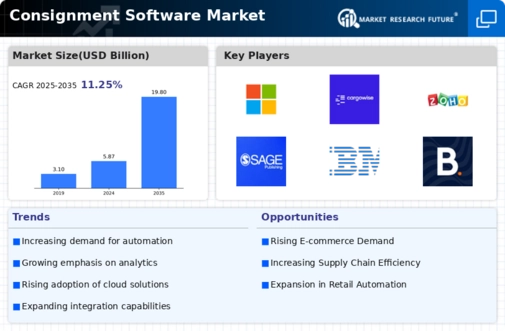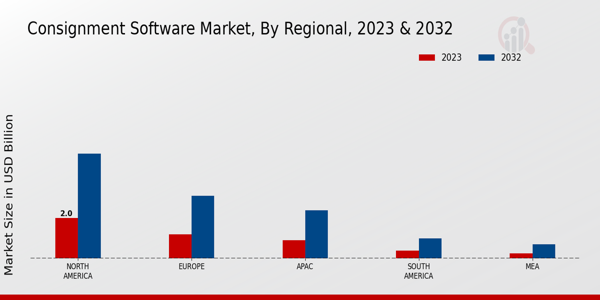Rise of E-commerce and Online Retail
The proliferation of e-commerce and online retail platforms significantly influences the Global Consignment Software Market Industry. As more consumers turn to online shopping, businesses must adapt their inventory and consignment strategies to meet evolving consumer demands. This shift necessitates robust software solutions that can manage consignment processes efficiently. The market is expected to expand, with projections indicating a growth to 19.8 USD Billion by 2035. This growth underscores the necessity for consignment software that can seamlessly integrate with e-commerce platforms, thereby enhancing the overall customer experience and operational efficiency.
Expansion of Small and Medium Enterprises
The expansion of small and medium enterprises (SMEs) significantly impacts the Global Consignment Software Market Industry. SMEs are increasingly adopting consignment software to manage their inventory and streamline operations, recognizing the potential for improved efficiency and cost savings. This trend is particularly pronounced in emerging markets, where SMEs are vital to economic growth. As these businesses continue to grow, the demand for consignment solutions is expected to rise, contributing to the overall market expansion. The increasing number of SMEs adopting such technologies suggests a promising future for the consignment software sector.
Increased Focus on Supply Chain Transparency
The Global Consignment Software Market Industry is witnessing a heightened emphasis on supply chain transparency. Stakeholders, including consumers and regulatory bodies, demand greater visibility into the sourcing and distribution of products. Consignment software facilitates this transparency by providing real-time tracking and reporting capabilities. Companies that adopt such solutions can enhance their reputation and build trust with consumers. This trend is likely to drive market growth as businesses recognize the importance of transparency in fostering customer loyalty and meeting regulatory requirements.
Technological Advancements in Software Solutions
Technological advancements play a pivotal role in shaping the Global Consignment Software Market Industry. Innovations such as artificial intelligence, machine learning, and cloud computing are increasingly integrated into consignment software, enhancing its functionality and usability. These technologies enable businesses to analyze data more effectively, forecast demand, and optimize inventory levels. As a result, companies are likely to invest in advanced consignment solutions to remain competitive. The anticipated compound annual growth rate of 11.67% from 2025 to 2035 highlights the potential for growth driven by these technological enhancements.
Growing Demand for Inventory Management Solutions
The Global Consignment Software Market Industry experiences a notable surge in demand for efficient inventory management solutions. Businesses increasingly seek to streamline their operations, reduce excess stock, and enhance order fulfillment processes. This trend is particularly evident in sectors such as retail and e-commerce, where effective inventory management is crucial for maintaining competitiveness. As a result, the market is projected to reach 5.87 USD Billion in 2024, reflecting a growing recognition of the importance of consignment software in optimizing inventory control and improving overall operational efficiency.

























Leave a Comment